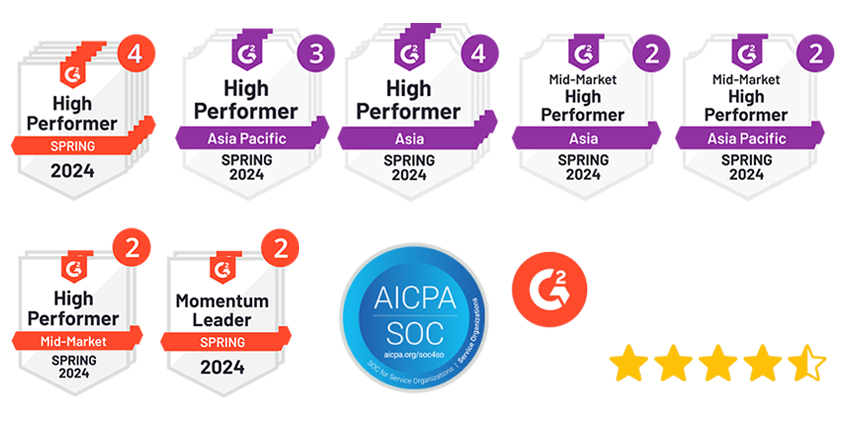Do you know how much time and money your business loses because of mismatched purchase orders (POs) and invoices? Errors like overpayments and delayed payments can quickly add up, affecting cash flow and supplier relationships. For large enterprises, these issues can easily spiral out of control unless you have the right system in place.
PO matching ensures that the information on a purchase order aligns with the details on the invoice. This simple but essential step helps businesses avoid paying for items they didn’t order or receive. It also improves accuracy, speeds up payment processing, and keeps financial operations running smoothly.
However, many businesses are still dependent on manual processes, leaving room for mistakes and inefficiencies. In this blog, we’ll explore how automating PO matching can reduce errors, save valuable time, and boost your company’s financial health.
Read on to learn how the right system can make all the difference in your accounts payable process.
What is PO Matching?
PO Matching is the process of ensuring that the details on a purchase order (PO) align with the information on an invoice before processing payment. This process plays a key role in Accounts Payable (AP), helping businesses verify the accuracy of their purchases and avoid unnecessary errors or overpayments.
In simple terms, PO matching involves comparing three main documents:
- Purchase Order (PO): A document created by a business that outlines what products or services have been ordered, their quantities, prices, and terms.
- Invoice: A bill sent by the supplier after delivering goods or services, which lists the amount due based on the order.
- Goods Receipt (if applicable): A document or acknowledgment confirming that the business received the ordered goods or services.
For businesses, PO matching is important to ensure that what was ordered is what was delivered and that what is being billed matches the agreed-upon terms. A mismatch, whether in price, quantity, or any other terms, could lead to overpayments, disputes, or errors in financial reporting.
Example: Let’s assume a company called ABC Electronics, which specializes in selling computer parts. ABC Electronics places an order with Tech Supplies, a supplier, for 100 high-end processors at $200 each.
The purchase order (PO) from ABC Electronics clearly states:
- 100 processors at $200 each
- Total cost: $20,000
- Delivery expected in 7 days
A few days later, Tech Supplies sends an invoice for 100 processors at $200 each, totaling $20,000. At first glance, everything matches perfectly. But before ABC Electronics makes any payment, they need to ensure:
- Quantity: The PO lists 100 processors. The invoice should reflect the same amount.
- Price: The agreed price per processor was $200. The invoice should confirm this.
- Delivery Confirmation: ABC Electronics will check if the goods have been received in full as per the PO. If the invoice is for 100 processors, they should have received 100 processors.
If everything matches, the payment can be processed smoothly. If there’s any discrepancy, like the invoice lists 110 processors or charges an extra $10 per processor, the AP team needs to investigate and resolve it before making any payment.
So, PO prevents situations where companies pay for incorrect quantities, overcharge, or even accidentally pay for items that were never ordered. By catching these discrepancies early, businesses avoid unnecessary costs and protect their financial integrity.
Now that we understand the basics of PO matching, let’s explore the different types of invoice and PO matching processes with some example scenarios to understand and differentiate between them.
Types of Invoice and PO Matching Processes
There are several methods businesses can use to match purchase orders (POs) and invoices. Each method varies in complexity, and the choice of method depends on the business’s needs, size, and the level of accuracy required. Let’s take a look at the most common types of matching processes used in accounts payable:
1. Two-Way Matching
Two-way matching is the simplest and most commonly used process. In this approach, the invoice is compared directly with the purchase order (PO) to ensure the details match before payment is made. This method checks:
- Price: Does the price on the invoice match the agreed price on the PO?
- Quantity: Are the quantities on the invoice the same as what was ordered?
Example: ABC Manufacturing orders 500 boxes of screws from a supplier. The PO specifies 500 boxes at $10 each. When the supplier sends the invoice for 500 boxes at $10 each, the accounts payable team checks the invoice against the original PO. If the price and quantity match, the invoice is approved for payment.
Two-way matching works well for straightforward purchases where the order and invoice details are clear and simple. However, it might not cover all the complexities, such as delivery discrepancies or incomplete orders.
2. Three-Way Matching
Three-way matching adds a layer of verification by comparing the purchase order (PO), invoice, and Goods Receipt Note (GRN) or delivery note. This method ensures that:
- The PO and invoice match: Just like two-way matching, the invoice details must align with the purchase order.
- The delivery matches the PO: The goods receipt confirms that the items ordered have been received in the correct quantity and quality.
Example: XYZ Electronics orders 200 laptops from a supplier. The PO specifies 200 laptops at $500 each. When the shipment arrives, XYZ Electronics signs off on the goods receipt, confirming that 200 laptops were delivered. The supplier then sends an invoice for 200 laptops at $500 each.
The accounts payable team will perform three-way matching by comparing:
- The PO: 200 laptops at $500 each.
- The goods receipt: 200 laptops received.
- The invoice: 200 laptops at $500 each.
If all three documents align, the payment is processed. If there is a discrepancy, such as a shortage in delivery or incorrect invoicing, the payment is delayed until the issue is resolved.
Three-way matching provides extra accuracy, particularly when dealing with physical goods and larger orders.
3. Four-Way Matching
Four-way matching is used for even more complex transactions, especially when a business needs to verify additional details. In this process, four documents are compared:
- Purchase Order (PO)
- Invoice
- Goods Receipt (GR)
- Receiving Report (sometimes referred to as a packing slip or delivery note)
The fourth document is important for situations where businesses need to confirm not only that goods were received but also that they were in good condition and as ordered.
Example: ABC Supplies orders 1,000 office chairs from a supplier. The PO specifies 1,000 chairs at $50 each, and a goods receipt confirms delivery. However, the receiving report indicates that 50 chairs were damaged during transit. The supplier’s invoice asks for payment for all 1,000 chairs, but the receiving report reveals a discrepancy.
With four-way matching, ABC Supplies will only approve payment for the 950 undamaged chairs that were correctly delivered. This method ensures that every aspect of the transaction is double-checked for both quality and quantity.
Choosing the Right PO and Invoice Matching Process
- Two-way matching is ideal for simpler, less complex transactions.
- Three-way matching is best when you need to ensure that the ordered goods are delivered as promised.
- Four-way matching is used for more intricate purchases, where quality control and verification are necessary.
The choice between two-way, three-way, and four-way matching depends on your business needs:
Let’s now explore their benefits and discover how they can transform your accounts payable process and boost your business efficiency.
Benefits of PO Matching
Implementing a PO matching process in accounts payable brings several key benefits to businesses. It helps organize operations, reduce costs, and enhance financial accuracy. Let’s explore some of the most important benefits:
1. Improved Accuracy
By matching the purchase order (PO) with the invoice, businesses ensure that they only pay for what was ordered and delivered. This prevents mistakes like overpaying or paying for items that weren’t received. With automated PO matching, the chances of human error are drastically reduced, leading to more accurate financial records.
2. Better Cash Flow Management
When POs and invoices are accurately matched, businesses avoid unnecessary payments and ensure they only pay for what they owe. This helps maintain a healthy cash flow because companies can better track and manage their payments. With fewer discrepancies and delays in payment, companies can plan for growth and maintain strong relationships with vendors.
3. Reduced Risk of Fraud
PO matching adds an extra layer of security by confirming that the goods or services billed were ordered and received. This reduces the risk of fraud and ensures that no unauthorized transactions are processed. If an invoice is not matched to a PO or if it doesn’t match the details, the system flags it, allowing businesses to investigate potential issues before payment is made.
4. Enhanced Supplier Relationships
When payments are processed accurately and on time, it builds trust with suppliers. Invoice matching helps ensure that invoices are paid correctly and promptly, which can lead to better terms and stronger partnerships. Suppliers appreciate businesses that are organized and timely with payments, which can lead to discounts, priority service, or other benefits.
5. Streamlined Audit Process
Having accurate and matched records makes it easier to perform audits. When POs, invoices, and payments are correctly aligned, auditors can quickly verify transactions. This reduces the time and effort required during an audit, making the process smoother and less stressful. It also ensures that businesses remain compliant with regulations, preventing costly penalties.
6. Increased Operational Efficiency
Automating the PO matching process saves a significant amount of time compared to manual matching. By regulating the invoice approval process and reducing the need for manual checks, businesses can free up their AP teams to focus on more strategic tasks. This leads to faster processing times and a more efficient workflow overall.
7. Cost Savings
The more accurate your invoice and PO matching, the less likely your company is to incur costly mistakes. For example, when errors are avoided, businesses prevent overpayments or duplicate payments, which saves money in the long term. Plus, automating PO matching reduces the amount of time your team spends on manual processes, leading to labor cost savings.
Pro Tip: Peakflo’s automated PO matching allows you to set up customized rules for automatic matching. This ensures that only accurate invoices are processed. It also reduces time spent on manual checks, accelerates approvals, and helps optimize cash flow, leading to time and cost savings for your business.
8. Improved Compliance
Many industries have strict regulations regarding financial record-keeping. PO matching helps ensure that your records comply with these regulations. When everything matches correctly, it’s easier to meet compliance standards, reduce audit risks, and avoid penalties.
By improving accuracy, reducing the risk of fraud, and enhancing cash flow, your business can operate more efficiently and confidently.
Having covered the benefits of PO matching, let’s take a closer look at some of the common challenges in PO matching and how they can impact your accounts payable process.
Challenges in PO Matching
Even with an automated system, PO matching presents challenges. Large enterprises process thousands of invoices, and any mismatch can slow down payments and disrupt operations. Below are some common issues businesses face in PO matching and how they impact accounts payable.
1. Data Entry Errors
A simple typo can cause an invoice to be flagged as a mismatch. If a vendor accidentally enters the wrong price, quantity, or PO number, the system may reject the invoice, leading to delays. Manual data entry increases the risk of such errors, making automation important for accuracy.
2. Missing or Incomplete Information
Sometimes, invoices lack necessary details like PO numbers, descriptions, or tax breakdowns. Without a clear reference, the AP team must manually verify details, which slows down processing. Missing information often leads to back-and-forth communication with vendors, further delaying payments.
3. Price and Quantity Discrepancies
Vendors may apply price changes due to market fluctuations or additional costs. If the invoice reflects a different rate than the PO, it creates a mismatch. Similarly, partial deliveries or incorrect quantities can cause discrepancies. Resolving these issues requires careful review and vendor collaboration.
4. Unmatched Freight or Tax Charges
Some invoices include additional charges for shipping, handling, or taxes that were not specified in the original PO. If these costs are not accounted for in the PO matching system, the invoice may be flagged as incorrect. Businesses need a flexible system that can accommodate such variances while maintaining accuracy.
5. Delayed Goods Receipt Updates
Three-way and four-way matching rely on a goods receipt confirmation. If the receiving team fails to update the system in time, the invoice may not match the PO, causing unnecessary payment delays. Clear coordination between procurement, receiving, and AP teams is important.
6. Duplicate Invoices
Vendors may mistakenly send duplicate invoices, leading to potential overpayments. If a business does not have a robust system to flag duplicates, it risks paying the same invoice twice. Automated matching with built-in duplicate detection helps prevent this issue.
7. Handling Non-PO Invoices
Not all invoices are tied to a purchase order. Service-based expenses, utilities, and subscription fees often don’t have a corresponding PO, making them difficult to match. Businesses must establish a separate approval workflow to manage non-PO invoices efficiently.
8. Resistance to Automation
Many organizations still rely on manual processes, either due to a lack of awareness or resistance to change. Teams accustomed to paper-based approvals may struggle to transition to digital workflows. Proper training and a user-friendly system can help ease this shift and improve efficiency.
Overcoming these challenges requires a well-structured process, automation, and strong coordination between teams. Now, let’s explore how businesses can automate PO matching.
How Automation Enhances PO Matching
Manual PO matching takes time and is prone to errors. Automation speeds up the process, reduces mistakes, and ensures accuracy. Here’s how it helps:
1. Faster Invoice Processing
Automated systems scan invoices and match them with POs in seconds. They also check key details like prices, quantities, and tax amounts instantly, eliminating the need for manual data entry and speeding up approvals.
2. Fewer Errors
Automation reduces human mistakes. Optical character recognition (OCR) extracts data from invoices and enters it into the system. Machine learning detects mismatches and flags them for review, ensuring that only accurate invoices are processed.
3. Real-Time Matching
Automation matches invoices with POs and receipts in real time. If there’s an issue, the system alerts the AP team immediately. This prevents last-minute delays and speeds up dispute resolution.
4. Seamless Approval Workflows
Approval rules are built into the system. When an invoice meets the matching criteria, it gets approved automatically. If there’s a mismatch, the system routes it to the right person for review. This ensures smooth workflows and faster decision-making.
5. Automatic Fraud Detection
Duplicate invoices and unauthorized charges are flagged instantly. Automation tracks payment history and vendor behavior to spot unusual patterns. This helps businesses prevent fraud and avoid overpayments.
6. Better Vendor Relationships
Faster payments mean happier vendors. Automated systems ensure that invoices are processed on time, reducing disputes. Vendors get paid without unnecessary delays, strengthening business relationships.
7. Easy Tracking and Audits
All transactions are recorded in a centralized system. Businesses can track every invoice, PO, and approval step with a few clicks. This makes audits easier and ensures compliance with financial regulations.
8. Scalability for Growth
As businesses grow, manual PO matching becomes unmanageable. Automation handles high volumes without extra work. Companies can process thousands of invoices efficiently, no matter how fast they scale.
With automation, PO matching becomes faster, more accurate, and stress-free. In the next section, we’ll explore the key features to look for in an automated PO matching system.
Real-World Success Stories
Several companies have experienced significant improvements by implementing automated PO matching:
1. Nomura Research Institute (NRI) Indonesia Saved 54 man-hours With PO Matching
NRI’s AP team manually matched purchase orders with invoices and shipping lists. If there were any discrepancies, the AP team notified the Procurement team, which then contacted the vendor to request corrections. This process was inefficient and took significant time. By implementing an automated three-way matching and validation, NRI saved 54 man-hours.
Read the NRI’s full case study here.
2. Vida Takes Less Than Three Days From PO to Invoice Approval
Vida’s finance team relied on manual approvals through JIRA, emails, and personal messages. This created delays and inefficiencies in processing purchase orders (POs) and invoices. Approvals often took anywhere from a week to a month, slowing down payments and disrupting cash flow. Vida automated its approval process, eliminating the need for manual follow-ups. The entire process, from PO to invoice approval, now takes less than three days, helping Vida improve efficiency and maintain smooth financial operations.
Read Vida’s full case study here.
Why Peakflo is the Best Solution for PO and Invoice Matching in Accounts Payable
Matching purchase orders (POs) with invoices can be slow and frustrating. Manual work leads to errors, delays, and extra costs. Peakflo makes this process easy by using smart automation. Here’s how Peakflo improves PO matching in accounts payable:
1. AI-Powered PO Matching Status

2. Automatically Match Invoices Without PO Numbers

Manually checking invoices and PO details takes too long. Peakflo scans invoices, identifies PO numbers, and sorts matches into four categories: perfect, close, warning, or error. This helps streamline the process, saving time and preventing errors.
If an invoice is missing a PO number, Peakflo doesn’t leave it to chance. It automatically checks other details, like vendor information, item descriptions, and amounts, to find the correct match. This eliminates delays and removes the guesswork from the process.
3. Smart Matching Across Different Formats

Vendors may use different descriptions, currencies, or units of measurement. This can create mismatches and slow down payments. Peakflo fixes this by recognizing and aligning details, even when formats differ. It ensures accurate PO matching, reducing errors and preventing unnecessary back-and-forth.
4. Ensure Accuracy with High Matching Probability

With smart PO matching, you can view the probability of each bill line item matching a PO line item. This helps your team confidently validate matches and reduce manual errors. By monitoring these match scores, finance teams can ensure greater accuracy and speed in processing.
5. Automatic Approval for Small Price Differences

Some price differences are too small to matter, but manual checks still slow things down. Peakflo allows finance teams to set a tolerance limit for minor changes, like slight unit price adjustments. This prevents delays while keeping payments accurate and under control.
6. Quickly Spot and Fix Mismatches

Peakflo automatically flags missing or incorrect details, like payment terms or pricing errors. Instead of long email chains, finance teams can message vendors directly from the PO matching window. All messages and responses are saved in a timeline, making it easy to track and resolve issues quickly.
By automating PO matching, Peakflo removes errors, saves time, and makes accounts payable smooth and stress-free. Businesses can pay vendors faster, stay organized, and improve financial accuracy.
Conclusion
Matching purchase orders (POs) to invoices should be simple, but it often slows finance teams down. Manual checks, mismatched details, and long approval times delay payments and create extra work. Peakflo’s AI-powered PO matching fixes this by automating the process. It instantly connects invoices to POs, highlights errors, and speeds up approvals. No more searching through emails or checking details by hand.
Make PO matching fast and stress-free. Book a demo with Peakflo today and see how easy it can be.










![Why AI Sales Calls Are Making Good Sales Reps Even Better [2025 Guide] ai sales calls](https://blog.peakflo.co/wp-content/uploads/2025/09/65168cf6-3001-4733-8cbc-12d5684cf449-218x150.webp)


































